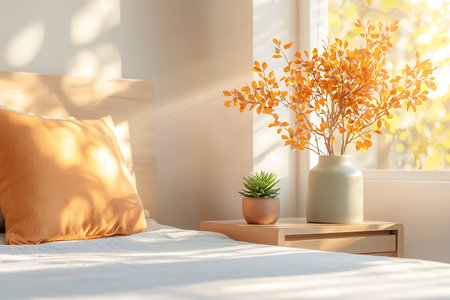Understanding the Bagua Map: A British Perspective
The Bagua Map, a cornerstone of Feng Shui practice, has its roots in ancient Chinese philosophy. Traditionally used to analyse and enhance the energy flow within spaces, this octagonal grid serves as a guide to harmonise our environments with the natural world. In recent years, the Bagua Map has found its way into British homes, where its principles are being thoughtfully adapted to suit contemporary UK lifestyles. For many Britons seeking balance amidst urban bustle or countryside calm, the Bagua Map offers an intriguing bridge between time-honoured Eastern wisdom and the practicalities of modern British living. By mapping out our living spaces according to the Bagua’s sectors—each representing aspects such as wealth, health, and relationships—homeowners across the UK are discovering new ways to cultivate harmony and positive energy at home. This integration not only enriches personal wellbeing but also reflects the growing appreciation for global philosophies that complement Britain’s own traditions of comfort and sanctuary.
2. Mapping Your Home: Applying the Bagua Grid in British Spaces
Integrating the ancient wisdom of the Bagua Map into a British home begins with understanding both your property’s unique layout and the fundamental principles of Feng Shui. Whether you reside in a Victorian terrace, an Edwardian semi-detached, or a sleek modern flat, overlaying the Bagua Map can bring balance and clarity to your living environment. Here’s a step-by-step guide tailored for typical British spaces:
Step 1: Identify Your Home’s Main Entrance
The Bagua Map always starts from the main entrance. In traditional British homes, this might be a front door leading into a hallway or directly into a lounge. Stand at your main entryway—this will orient your map correctly.
Step 2: Obtain or Draw Your Floor Plan
If you have an architectural drawing of your home, use it; otherwise, sketch a simple outline of your space, including all rooms and extensions. Be sure to note any irregularities common in British architecture, such as bay windows or conservatories.
Step 3: Overlay the Bagua Grid
The Bagua is typically represented as a nine-square grid (three by three), each section symbolising an aspect of life (e.g., Wealth, Health, Relationships). Align the bottom edge of the grid with your home’s main wall containing the entrance.
| Bagua Area | Life Aspect | Typical Room Examples (UK Homes) |
|---|---|---|
| Front Left | Knowledge & Wisdom | Study, Hallway Nook |
| Front Centre | Career & Life Path | Main Hallway, Entry Vestibule |
| Front Right | Helpful People & Travel | Cloakroom, Porch |
| Middle Left | Family & Health | Lounge, Sitting Room |
| Centre | Health & Wellbeing | Main Landing, Staircase Area |
| Middle Right | Creativity & Children | Diner, Conservatory, Playroom |
| Back Left | Wealth & Abundance | Kitchens in Victorian Terraces or Dining Rooms in Semis |
| Back Centre | Fame & Reputation | Sitting Room with Garden Access, Patio Doors in Flats |
| Back Right | Relationships & Love | Main Bedroom or Guest Room at Rear of Property |
Navigating Irregularities in British Homes
If your property has an L-shape extension or bay window—a feature common to many period homes—extend the Bagua grid across the entire footprint. Unused corners may require adjustment by enhancing them with mirrors or plants to symbolically ‘complete’ missing sections.
Quick Tips for British Layouts:
- Narrow Terraces: Use vertical accents (like tall bookcases) to emphasise upward energy and avoid cluttered hallways.
- Semi-Detached Houses: Mind shared walls; introduce soundproofing features for privacy and harmony.
- Modern Flats: Emphasise natural light with mirrors if windows are limited; define each Bagua sector with décor changes rather than physical walls.
This methodical application allows you to honour both the character of your British residence and the universal energies mapped out by Feng Shui. With your Bagua Map properly aligned, you’re poised to start harmonising every room—one step closer to balanced living.

3. The Eight Areas: What Each Represents and Their Modern Relevance
The Bagua Map is divided into eight distinct sectors, each symbolising a core aspect of life that contributes to overall harmony and wellbeing. Understanding these areas—and their resonance with contemporary British values—can help you create a space that truly supports your aspirations.
Wealth & Prosperity (Xun)
This sector governs abundance, financial growth, and personal prosperity. In the UK, where many value financial security and stability, enhancing this area can mean not only attracting material wealth but also fostering a sense of gratitude for what one already possesses. Using hues of green or symbols like flourishing plants can evoke both traditional Feng Shui principles and the modern British love for gardens and nature.
Fame & Reputation (Li)
Associated with recognition and how one is perceived in society, this area aligns well with the British appreciation for integrity, honour, and community standing. By thoughtfully arranging lighting or displaying awards here, you reinforce your own values while celebrating achievements—be they academic, professional, or charitable.
Relationships & Love (Kun)
This sector supports romantic partnerships and close friendships, reflecting the importance placed on personal connections within British culture. Incorporating pairs of objects or soft textiles can foster warmth and intimacy—a nod to both tradition and the modern desire for comforting, inviting homes.
Family & Health (Zhen)
The family area is intrinsically tied to ancestry and wellbeing. In today’s UK households—where family structures are diverse yet deeply cherished—placing heirlooms or family photos here honours heritage while promoting physical and emotional health. Greenery also brings in a touch of Britain’s lush countryside indoors.
Centre: Health & Balance (Tai Qi)
The heart of the Bagua Map signifies holistic wellbeing. Its modern relevance is profound: in an age where work-life balance is often elusive, creating openness at the centre of your home can encourage calmness and clarity—qualities valued by those seeking refuge from busy urban lives.
Creativity & Children (Dui)
This area nurtures inspiration, artistic pursuits, and joy—themes reflected in Britain’s vibrant arts scene and commitment to fostering creativity among young people. Displaying art supplies or children’s crafts here celebrates innovation and playfulness alike.
Knowledge & Self-Cultivation (Gen)
Symbolising education and self-improvement, this sector resonates with a nation renowned for its literary tradition and world-class educational institutions. A reading nook or study area here encourages lifelong learning—a value as relevant today as ever.
Career & Life Path (Kan)
Reflecting professional growth and life journey, this area mirrors the UK’s strong work ethic and respect for personal progress. Placing a desk or motivational quotes here can inspire ambition while reminding you to chart your own unique course.
Helpful People & Travel (Qian)
This sector invites mentorship, support networks, and opportunities for exploration—qualities embodied in British hospitality and global curiosity. A bowl for keys or souvenirs from travels connects you to helpful energies both near and far.
Together, these eight areas form a blueprint for living harmoniously within your space—blending ancient wisdom with the aspirations of modern British lifestyles.
4. Feng Shui Remedies with a British Touch
Infusing the ancient wisdom of Feng Shui with British charm not only makes the practice more relatable, but also ensures your home reflects both harmony and heritage. Here, we explore practical ways to enhance each area of the Bagua Map using quintessentially British items, blending tradition with local personality for optimal energy flow.
Practical Enhancements for Every Bagua Area
From the iconic garden gnome to the classic Union Jack cushion, British households are brimming with objects that can be thoughtfully placed to activate the energy in each zone. Below is a table offering tailored suggestions:
| Bagua Area | Element | British Remedy |
|---|---|---|
| Wealth & Prosperity (Southeast) | Wood | Place a lush potted fern in a William Morris planter or an antique wooden box filled with coins as a nod to abundance. |
| Fame & Reputation (South) | Fire | Add a red tartan throw or display brass candlesticks on the mantelpiece for warmth and recognition. |
| Love & Relationships (Southwest) | Earth | Use matching teacups from a fine bone china set or rose-patterned cushions to encourage harmony. |
| Family & Health (East) | Wood | A framed family photo atop an oak sideboard or a vase of fresh daffodils brings vitality and connection. |
| Centre (Tai Chi) | Earth | A ceramic bowl with polished stones or a patchwork rug grounds the energy at your home’s heart. |
| Children & Creativity (West) | Metal | Display whimsical garden gnomes or silver picture frames containing children’s artwork to inspire joy. |
| Knowledge & Wisdom (Northeast) | Earth | Create a cosy reading nook with leather-bound classics and an armchair draped in Harris Tweed. |
| Career & Life Path (North) | Water | An elegant blue vase, vintage umbrella stand, or small indoor water feature channels clarity and opportunity. |
| Helpful People & Travel (Northwest) | Metal | A silver-plated bell, world atlas, or travel souvenirs—like a London Underground map—invite support and adventure. |
Cultural Fusion Tips
- Bespoke Accessories:Personalise remedies by incorporating family heirlooms, such as inherited clocks or historic pub signs.
- Scent and Ambience:Use English lavender sachets for calm, or light Earl Grey-scented candles to boost mood in living areas.
- Clever Colour Choices:Embrace classic British hues—deep greens, navy blues, and soft greys—to align décor with Bagua energies.
The Subtle Power of Local Traditions
Integrating national symbols like Union Jack cushions, Royal commemorative plates, or even cricket bats as decorative accents can imbue your space with familiarity and pride while enhancing Feng Shui intentions. Remember: placement should feel natural rather than forced; let your home’s history guide you as much as its energy map.
Nurturing Harmony The British Way
By weaving together Feng Shui principles and beloved British motifs, you create interiors that are not just balanced but truly personal. This fusion ensures that harmony is not only achieved but celebrated every day within your uniquely curated home.
5. Common Pitfalls and Local Solutions
Navigating Typical British Home Challenges
Applying the Bagua Map in a UK setting often means working with architectural quirks unique to British homes. From Victorian terraces to modern flats, space can be at a premium, and certain layouts may seem at odds with the principles of harmonious energy flow. Here, we address some of the most frequent challenges and offer practical feng shui solutions tailored specifically for the British context.
Narrow Hallways: Channelling Energy Instead of Confining It
Narrow or elongated hallways are a hallmark of many UK houses, particularly older properties. These corridors can cause chi (energy) to rush through too quickly or become stagnant. To counteract this, place artwork or mirrors on the walls to visually widen the space and slow down energy flow. Opt for gentle lighting and use runners or rugs with subtle patterns to encourage movement without overwhelming the senses. A well-placed plant near the end of the hallway can further uplift chi and invite positive energy into adjoining rooms.
North-Facing Rooms: Brightening Up the Shadows
Many British homes feature north-facing rooms that receive limited sunlight, resulting in colder, darker spaces often associated with lower energy levels. In feng shui terms, these areas can feel yin-heavy and lack vibrancy. To remedy this, incorporate warm-toned furnishings—think ochre cushions, honey-coloured woods, or golden accents—to introduce yang energy. Strategically placed mirrors can help reflect what natural light is available, while soft lamps with warm bulbs create a cosier atmosphere. If possible, introduce images or symbols representing fire and life, such as candles or lively artwork, to activate the space according to Bagua principles.
Multifunctional Living Spaces: Harmonising Work and Leisure
With many UK residents working from home in compact flats or shared houses, living spaces often serve double duty. To maintain balance, use screens or bookshelves to subtly divide work zones from relaxation areas. According to the Bagua Map, ensure your desk is positioned so you have a clear view of the door (the “command position”), which promotes focus and control. Keep clutter at bay by adopting clever storage solutions—an essential tip for UK homes where space comes at a premium.
Embracing Heritage While Inviting Harmony
No matter how traditional or modern your home may be, these locally attuned feng shui adaptations allow you to harness the wisdom of the Bagua Map within the distinctive context of British living. By thoughtfully addressing common pitfalls—from narrow hallways to north-facing rooms—you can foster an environment that supports both harmony and heritage.
6. Blending Tradition with Modernity: Creating Harmony at Home
Striking a balance between the ancient wisdom of the Bagua Map and the clean lines of contemporary British interiors may seem a challenge, yet it offers an opportunity for genuine harmony. The secret lies in integrating core feng shui principles—such as mindful placement, decluttering, and enhancing natural light—within the context of today’s design sensibilities.
Respecting Heritage, Reflecting Personality
Begin by appreciating the energy flow each Bagua zone represents, then select modern furnishings that echo these intentions. For instance, in your Wealth corner, you might opt for a sleek brass lamp or an elegant houseplant rather than ornate traditional objects. This subtle nod to tradition aligns with Britain’s appreciation for understated elegance and individual expression.
Colour and Material Choices
Classic British homes often favour neutral tones paired with splashes of colour. Let the Bagua guide your choices: bring soft green cushions into your Family area for growth, or a bold red vase into your Fame sector for vitality. Use sustainable materials—wool throws, oak tables, or ceramic accents—to ground spaces in both nature and local craftsmanship.
Practical Tips for Everyday Harmony
Ensure walkways are clear to encourage positive chi. Maximise daylight with sheer curtains and well-placed mirrors—a nod to both feng shui and the British love for brightening interiors during grey months. Incorporate artwork or heirlooms that tell your story while respecting the Bagua zones they inhabit, blending personal history with harmonious intention.
Ultimately, embracing the Bagua Map doesn’t require sacrificing modern comfort or style; rather, it invites you to weave together East and West, old and new. By doing so, you create a living space that feels welcoming, balanced, and unmistakably yours—an authentic reflection of both heritage and modern British life.


